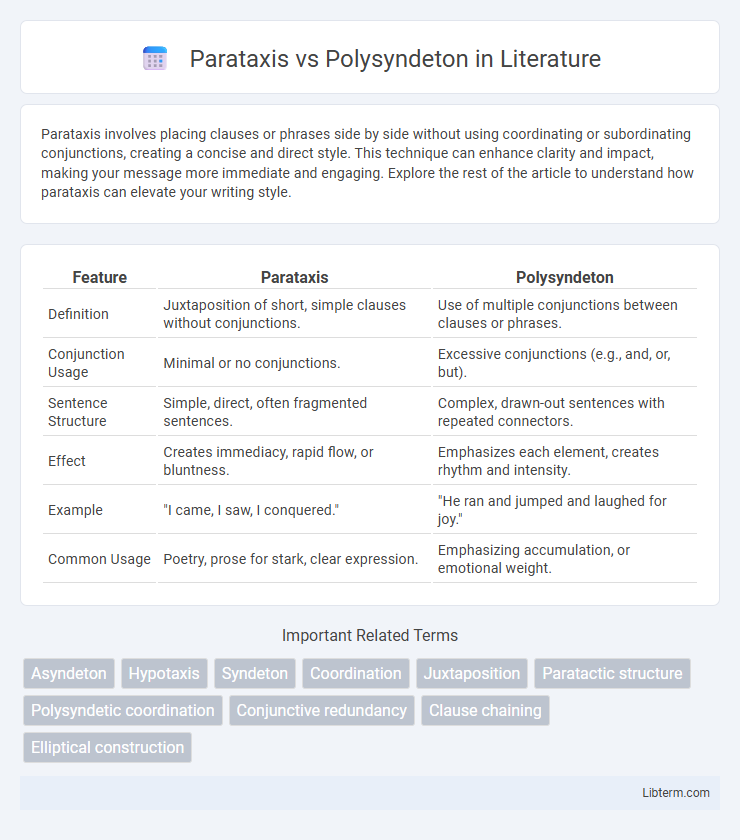Parataxis involves placing clauses or phrases side by side without using coordinating or subordinating conjunctions, creating a concise and direct style. This technique can enhance clarity and impact, making your message more immediate and engaging. Explore the rest of the article to understand how parataxis can elevate your writing style.
Table of Comparison
| Feature | Parataxis | Polysyndeton |
|---|---|---|
| Definition | Juxtaposition of short, simple clauses without conjunctions. | Use of multiple conjunctions between clauses or phrases. |
| Conjunction Usage | Minimal or no conjunctions. | Excessive conjunctions (e.g., and, or, but). |
| Sentence Structure | Simple, direct, often fragmented sentences. | Complex, drawn-out sentences with repeated connectors. |
| Effect | Creates immediacy, rapid flow, or bluntness. | Emphasizes each element, creates rhythm and intensity. |
| Example | "I came, I saw, I conquered." | "He ran and jumped and laughed for joy." |
| Common Usage | Poetry, prose for stark, clear expression. | Emphasizing accumulation, or emotional weight. |
Understanding Parataxis: Definition and Features
Parataxis is a literary technique characterized by placing phrases or clauses side by side without coordinating conjunctions, creating a concise and straightforward style. This method emphasizes simplicity and immediacy by using short, independent clauses often separated by commas or semicolons. Key features include equal syntactic importance among elements and a rhythm that mirrors natural speech, enhancing clarity and impact in both literary and rhetorical contexts.
What is Polysyndeton? Key Characteristics
Polysyndeton is a rhetorical device that involves the deliberate use of multiple conjunctions in close succession, often between every item in a list or phrase, to create a rhythmic and emphatic effect. Key characteristics include the repetition of conjunctions like "and," "or," and "but," which slows the pace of the sentence and adds weight to each element, enhancing the overall intensity and emotional impact. This technique contrasts with asyndeton by emphasizing the abundance and importance of each connected part through its persistent use of coordinating conjunctions.
Structural Differences: Parataxis vs Polysyndeton
Parataxis employs a straightforward structure by placing clauses or phrases side by side without conjunctions, creating a rapid, concise rhythm. Polysyndeton uses multiple conjunctions between each clause or phrase, slowing the pace and emphasizing each element. The structural difference lies in parataxis's omission of connectors versus polysyndeton's deliberate repetition of them.
Historical Origins and Literary Traditions
Parataxis and polysyndeton both have roots in ancient literary traditions, with parataxis found prominently in classical Greek and Latin texts where simple, direct clauses were placed side by side without conjunctions. Polysyndeton, characterized by the deliberate overuse of conjunctions like "and," traces back to Homeric epics, emphasizing rhythm and oratory impact in oral storytelling. These techniques reflect differing stylistic goals in historical literature: parataxis for clarity and immediacy, polysyndeton for emphasis and narrative pace.
Effects on Style and Tone
Parataxis creates a concise, straightforward style by placing clauses or phrases side by side without conjunctions, producing a rapid, impactful tone that often feels direct and immediate. Polysyndeton, with its repeated use of conjunctions between clauses, generates a rhythmic, deliberate style that can convey intensity, emphasis, or overwhelming abundance, often creating a more solemn or heightened emotional tone. Both techniques manipulate sentence structure to influence pacing and reader engagement, shaping the overall mood and stylistic impression of the text.
Usage in Classical and Modern Literature
Parataxis employs simple, short sentences or phrases placed side by side without conjunctions, prevalent in Classical literature like Homer's epics for direct, rhythmic storytelling. Polysyndeton uses multiple conjunctions between clauses, evident in the Bible and modern works by Faulkner, creating a deliberate, emphatic pace and emotional intensity. Both techniques manipulate sentence structure to influence narrative flow and reader engagement across literary periods.
Examples of Parataxis in Famous Works
Parataxis appears prominently in Ernest Hemingway's writing, such as in "The Old Man and the Sea," where short, simple sentences are placed side by side: "He was an old man who fished alone in a skiff in the Gulf Stream and he had gone eighty-four days now without taking a fish." Shakespeare's works also employ parataxis, for example in "Julius Caesar" with the line "I came, I saw, I conquered." These examples illustrate how parataxis creates a straightforward, impactful rhythm through the juxtaposition of independent clauses without conjunctions.
Polysyndeton in Poetry and Prose
Polysyndeton, characterized by the deliberate use of multiple conjunctions in close succession, enhances rhythm and emphasizes each element in poetry and prose. In poetry, polysyndeton creates a musical, flowing quality that intensifies emotional impact and highlights thematic depth. In prose, it slows the narrative pace, drawing attention to details and building a cumulative effect that mirrors complexity or overwhelming situations.
When to Use Parataxis or Polysyndeton
Parataxis is effective when creating a crisp, impactful flow by placing clauses or phrases side by side without conjunctions, enhancing clarity and urgency in storytelling or persuasive writing. Polysyndeton suits situations where an author wants to emphasize each element equally, slowing down the rhythm to create a sense of abundance or overwhelming detail, often used in emotional or dramatic contexts. Writers choose parataxis for simplicity and immediacy, while polysyndeton is preferred to add weight and cumulative effect to a series of ideas or actions.
Enhancing Writing: Choosing the Right Technique
Parataxis employs simple, short sentences or phrases placed side by side without conjunctions, creating a clear, fast-paced rhythm that enhances directness and impact. Polysyndeton uses multiple conjunctions between clauses, producing a deliberate, rhythmic emphasis that slows the pace and adds depth or intensity to the text. Selecting between parataxis and polysyndeton depends on the desired tone and effect; parataxis drives urgency and clarity, while polysyndeton enriches complexity and emotional weight.
Parataxis Infographic

 libterm.com
libterm.com